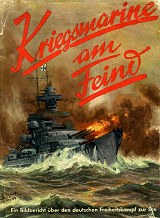 |
Home Intro Technical History Crew Models Gallery Kriegsmarine Archives
More Forum  UPDATES UPDATES |
Seekriegsleitung
Minutes of the Conferences of the Commander in Chief, Navy, and the Führer at Headquarters Berghof on 12 and 13 April 1944.
| Present: |
Reichsmarschall Göring Generaloberst Jodl |
1. TIRPITZ. The Commander in Chief, Navy, reports on the plans for the TIRPITZ. The ship is to be repaired and to remain stationed in northern Norway. This course will be followed even if further damage is sustained. Regardless of how much work and manpower may be involved, the repairs must be made. After all, the presence of the TIRPITZ ties up enemy forces. The ship will hardly have any further opportunity for combat, unless later political developments, such as a falling out between England and Russia, were to bring this about.
In any case, it is impossible to know what will happen. It is very unlikely that the TIRPITZ will be used in case of an invasion. Air attacks have shown that a ship is helpless without fighter escort. Therefore the idea of using the SCHARNHORST during the Arctic night was basically correct. Aside from the fact that the TIRPITZ will tie up enemy forces if left in northern Norway, it would be a mistake to recall the ship to Germany, since that would increase the danger of air raids on our German ports.
The Führer voices his wholehearted approval. He agrees with the Commander in Chief, Navy, on every point.
2. Vis Island (Lissa). General Jodl informs the Führer that the seizure of Vis [Croatian island in the Adriatic Sea] is purely a naval matter. There is a difference of opinion between the Navy on the one hand and the Army and the Luftwaffe on the other. The latter believes that the Navy is too weak to carry out the seizure. Moreover, it is doubtful whether Vis is worth the commitment of so many valuable forces, since it is a question whether we will be able to supply and hold it afterwards. The continual interference with German coastal shipping could not be stopped by the seizure of Vis, since the airports in Foggia and the ports on the southern coast of Italy are at the disposal of the British very close by.
The Commander in Chief, Navy, points out that Vis is a vulnerable spot on the Dalmatian Coast. Infiltration of enemy troops and weapons is easier through Vis than straight across the Adriatic from Italy. Therefore it is important to seize Vis. Our losses of transport vessels in this area are almost always caused by enemy air forces, which attack our ships even while they are lying in the harbor. Due to the losses which occurred in the meantime, our Navy has less transport space today than it had during the middle of March. Therefore the Commander in Chief, Navy, believes that Vis should be taken soon. Transport space is adequate. Naval escort forces will, of course, be unable to provide sufficient protection, especially in the event of destroyer attacks. Naturally, the Commander in Chief, Navy, is not at all certain that the British will use destroyers. Surprise is the most important element of the undertaking. Therefore the approach will have to be well camouflaged. In addition, the Commander in Chief, Navy, considers the support of our air forces as absolutely necessary for the invasion.
The Reichsmarschall is against the operation. First he asserts that the destroyers are too much of a danger. Then he claims that British planes from Foggia would appear during the landing at the latest and annihilate everything. General Jodl says that he and the Army also consider the risk too great. The Commander in Chief, Navy, advocates carrying out the plan and taking the risk. He refers to Lero, where British destroyers, afraid of the search receivers of our Air Force, did not appear either.
The Führer tends to agree with the Commander in Chief, Navy. He calls attention to the fact that the British are building an airport on Vis Island, which would make attacks on our supplies still easier. He also makes reference to the operation at Lero and its success in spite of the proximity of the enemy. On the other hand he also agrees with the Chief of the OKW that there is great danger from enemy planes and possibly from destroyer attacks, against which our own old torpedo boats would be powerless. It goes without saying that our Air Force would have to support the operation. The Commander in Chief, Navy, believes the operation could successfully be carried out under proper weather conditions and with the aid of dark nights. An essential condition would be the ability to keep the island supplied afterwards. The Führer believes that the latter is possible, if need be with the help of submarines. He reserves the decision on the seizure of Vis until the return of the officer who was sent by the OKW to investigate the above matters.
General impression: The Führer is inclined to agree with the Commander in Chief, Navy, but argues as follows: "If the Army is opposed to begin with, and the inner conviction is lacking, then nothing will come of it anyway."
3. Operation Against Convoys in the Arctic Ocean. The Commander in Chief, Navy, explains the part carrier-based planes are playing in the Arctic in connection with convoy operations. He points out that the submarines can no longer get near the convoys, and how close carriers have come to the Norwegian Coast. He shows how easily the Luftwaffe could have attacked the carrier by means of search receivers and torpedoes. This would have given our submarines a chance to get closer to the convoy, and thereby provided further opportunity for destroying valuable war materials intended for Russia.
The Reichsmarschall does not want to undertake this. He doubts that carrier-based planes alone prevent submarines from approaching the convoy. He considers the carriers too far from our air bases. The Führer supports the Commander in Chief, Navy, on all counts, and demands an attack on the aircraft carrier of the next PQ convoy. The Reichsmarschall declares his willingness hereafter to transfer forces to northern Norway for short periods of time. The Commander in Chief, Navy, points out that convoys are located not more than 3 days in advance. It is very doubtful that this would be long enough to effect the transfer. The Reichsmarschall believes that it would suffice if the ground installations were set up beforehand. He wants to begin work on these immediately, so that only the planes themselves would then have to be transferred. The Reichsmarschall gives corresponding orders to the Chief of the General Staff, Luftwaffe.
4. Submarine Warfare. With the aid of an English monthly report captured by the Japanese and giving data on Allied shipping losses and anti-submarine warfare, the Commander in Chief, Navy, shows the great extent to which naval forces were tied up by submarine warfare as early as January 1942. His estimate for the present time is much higher. The Reichsmarschall stresses the large number of enemy air forces tied up by submarine warfare. The Commander in Chief, Navy, points out that Churchill admitted in his last monthly report on submarine warfare, that an extraordinarily large number of forces is being tied up in this way. The Commander in Chief, Navy, therefore believes that submarine warfare must continue in spite of losses. The Commander in Chief, Navy, explains the submarine distribution for 15 April from the following points of view:
-
a. enemy forces tied up.
b. submarines in readiness in case of an invasion.
5. The Walter Submarine. The Commander in Chief, Navy, reports on the plan to change to the Walter Submarine, and mentions the bottleneck encountered in tube manufacture. Special measures may have to be taken. As the result of the priority granted the Luftwaffe, types XXI and XXIII have been delayed, causing other armament to suffer. An example of this occurred in the Augsburg Division of the Maschinenfabrik Augsburg-Nürnberg. The engines were not completed because too few construction workers were employed to repair bombing damages. And the ready submarine strakes could not be welded together because the engines were not ready.
The Führer admits that this is a great disadvantage. However, from a broader point of view, the "Jägerstab" will have to have this power. Otherwise industry might be destroyed still more, and thus submarine construction completely halted. The Reichsmarschall agrees wholeheartedly.
6. Small Battle Weapons. The Commander in Chief, Navy, indicates which small battle weapons he has now definitely decided upon.
7. The Führer and the Commander in Chief, Navy, privately discussed the Crimea, Odessa and other matters.
countersigned: Fregattenkapitän Pfeiffer

| Home Guestbook Quiz Glossary Help us Weights & Measures Video Credits Links Contact |

